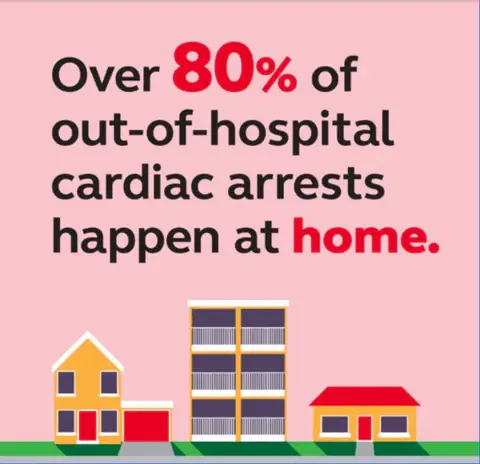The Silent Crisis at Home: Understanding the Alarming Reality of Cardiac Arrests
- Shane Yole
- Aug 13
- 4 min read
Cardiac arrest is a health emergency that can happen at any moment, and the statistics about it are both concerning and eye-opening. Shockingly, more than 80% of out-of-hospital cardiac arrests occur at home. This statistic highlights the urgent need for families to be ready to respond in such emergencies. Understanding this crisis is essential to raise awareness and take proactive measures that can save lives.

The Reality of Cardiac Arrests
Cardiac arrest occurs when the heart abruptly stops beating, cutting off blood flow to the brain and other essential organs. Unlike a heart attack, which results from a blocked blood flow to the heart, cardiac arrest can strike anyone, regardless of age or fitness level. Its sudden onset means that immediate action is vital for survival.
The fact that most cases happen at home emphasizes the importance of educating family members about cardiac arrest signs and the necessity of a quick response. Too many people may not realize they could be the first responder in these situations.
Recognizing the Signs
Being able to recognize the signs of cardiac arrest is crucial for effective intervention. Common symptoms include:
Sudden collapse
Unresponsiveness
No breathing or abnormal breathing (like gasping)
It is vital to understand that cardiac arrest can occur without any prior warning signs. Therefore, staying alert and prepared is especially important in a home setting, where professional help may not be available.
The Importance of CPR Training
Cardiopulmonary resuscitation (CPR) can significantly increase survival chances after a cardiac arrest. Research shows that administering CPR right away can double or even triple the likelihood of survival. In fact, survival rates for people who receive immediate CPR are two to three times higher compared to those who do not.
Families should look into local CPR training courses to learn how to respond effectively in emergencies. Many organizations offer free or low-cost training sessions, making it easier for everyone to become equipped with these life-saving skills.
The Role of Automated External Defibrillators (AEDs)
Automated External Defibrillators (AEDs) are portable devices designed to analyze the heart's rhythm and provide an electric shock if needed. Having an AED at home can make a crucial difference during a cardiac arrest.
Families should invest in an AED and also familiarize themselves with its operation. Most AEDs feature audio instructions and visual prompts, making them user-friendly, even for those without a medical background. According to studies, using an AED within the first few minutes of cardiac arrest can increase the chance of survival by up to 70%.
Creating a Family Emergency Plan
In addition to CPR training and having an AED, families must establish a detailed emergency plan. This plan should consist of:
Emergency contact numbers
A designated meeting place for family members
A list of medical conditions and medications for each family member
Practicing this plan regularly will ensure everyone knows their responsibilities in the event of a cardiac arrest.
The Impact of Lifestyle Choices
While cardiac arrest can happen to anyone, certain lifestyle choices can elevate the risk. Factors like poor diet, inactivity, smoking, and excessive alcohol intake contribute to heart disease, a leading cause of cardiac arrest.
Encouraging healthier habits within the family can lower the risk of heart events significantly. Simple changes, such as eating more fruits and vegetables, engaging in regular exercise, and managing stress, can have a notable impact on overall heart health. For instance, studies suggest that increasing physical activity can lower the risk of heart disease by 30-40%.
The Need for Community Awareness
While personal preparedness is vital, community awareness is equally important in tackling the silent crisis of cardiac arrests at home. Local organizations, schools, and healthcare providers should collaborate to promote heart health education and CPR training within the community.
Community events like health fairs, workshops, and free clinics can serve as valuable opportunities to spread information about cardiac arrest and the significance of a prompt response. Engaging the community increases the number of people who can act decisively during an emergency.
Final Thoughts
It is alarming that over 80% of out-of-hospital cardiac arrests occur in homes, serving as a wake-up call for families everywhere. By recognizing cardiac arrest signals, learning CPR, investing in an AED, and developing a household emergency plan, families can greatly enhance their preparedness and improve survival chances in critical situations.
Additionally, promoting a culture of heart health and community awareness can help mitigate risks associated with cardiac events. It is time to take action and prepare ourselves and our loved ones for this silent crisis looming within our households.
By focusing on education and readiness, we can change the conversation around cardiac arrests and ensure that more lives are saved when it matters the most.
Follow these short steps to learn how to save a life:
Steps
Shout for help, and shake the person gently.
Look and listen for signs of normal breathing.
Call (000) on loudspeaker and tell them the person isn’t breathing. The ambulance call handler will tell you where the nearest automated external defibrillator (AED) is. If someone is with you, ask them to fetch it and bring it back.
Interlock your fingers and start chest compressions twice per second. Don’t stop.
If a defibrillator arrives, switch it on and follow the instructions.
Continue CPR until: - the AED asks you to pause while it reanalyses and gives another shock if needed - a paramedic arrives and tells you what to do - the person shows signs of life.
With survival falling by around 10% every minute without CPR, it's essential to know the skills to try and save a life.










Comments